Equipped with either an 899cc ohv engine
(in the S,SX and Citymatic versions) with 39bhp or a 1108cc sohc FIRE engine
(in the 'Seicento Sporting') with 54bhp, the Seicento is designed for city driving
and frugality rather than performance, but the latter engine in the Sporting
does provide a good performance for such a small car. Electric power assistance
for the steering is an option (standard on The Citymatic features an automatic clutch
coupled with a conventional 5 speed manual transmission (ie two pedals
and a gear stick!) whilst an electric version, the Seicento elettra (the
only rear wheel drive Fiat at the time!) uses an ac three phase motor powered by lead acid batteries.
Click here
for more information on the Seicento Elettra.
The Sporting features modified suspension
(including the addition of a front anti-roll bar) and internal (including
the addition of a rev counter) and external trim. All models are available
with three doors only and are built at Tychy, in Poland.
With the New Panda taking most of the limelight, early 2004 saw a revised Fiat Seicento range released, with new interiors and a very
slightly changed exterior. Only the 1100cc engine with basic trim levels remained, other versions ceasing production (including the Sporting).
The Seicento Sporting Kit was built around the regulations for rallying and was without a doubt the most potent of the official
versions. With the engine capacity increased marginally to 1146cc and the use of four 38mm throttle bodies, it produced 128bhp @ 7,800rpm.
With Uno turbo ventilated discs at the front and 227mm solid discs at the rear it also stopped, whilst a fully rose-jointed supension, limited slip
differential, six-speed gearbox and weight of only 810kg meant it also handled. A complete cost of only 29000 Euro (in 2002) also made it somewhat of a bargain !
A hydrogen powered Seicento concept car was also built in 2005 as part of Fiat's development programme using fuel cells. Designed to replace the Cinquecento, the Fiat Seicento follows
in the great Fiat tradition of building outstanding small cars. It is heavily
based on the former car, using basically the same engines and running gear,
whilst the new bodyshell has been designed (in-house) to significantly improve the
safety of the occupants over its predecessor. To further this aim the Seicento
also comes equipped with front seatbelt pretensioners, energy absorbing
steering wheel, collapsing steering column and optional airbag and ABS.
Designed to replace the Cinquecento, the Fiat Seicento follows
in the great Fiat tradition of building outstanding small cars. It is heavily
based on the former car, using basically the same engines and running gear,
whilst the new bodyshell has been designed (in-house) to significantly improve the
safety of the occupants over its predecessor. To further this aim the Seicento
also comes equipped with front seatbelt pretensioners, energy absorbing
steering wheel, collapsing steering column and optional airbag and ABS.
 the
Citymatic) as are a range of 'Abarth' bodystyling accessories.
the
Citymatic) as are a range of 'Abarth' bodystyling accessories.
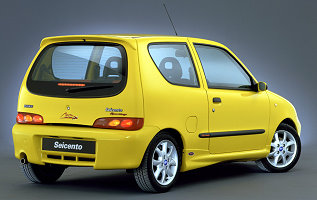 A mild facelift in 2000 was most easily
distinguishable by the new front bumper (and the adoption of the new round
Fiat badge) whilst the single point injection 900 and 1100 were both replaced
by a multipoint injection 1100 unit in order to become Euro 3 compatible. To celebrate Schumacher winning the F1 title in 2000 Fiat also produced (for
some markets) a Michael Schumacher Limited Edition Seicento.
A mild facelift in 2000 was most easily
distinguishable by the new front bumper (and the adoption of the new round
Fiat badge) whilst the single point injection 900 and 1100 were both replaced
by a multipoint injection 1100 unit in order to become Euro 3 compatible. To celebrate Schumacher winning the F1 title in 2000 Fiat also produced (for
some markets) a Michael Schumacher Limited Edition Seicento.
Technical Details
| Driveline | transverse engine at front with front wheel drive |
| Engines | 899cc (65x67.7mm) ohv 4 cylinder with 39bhp @ 5,500rpm
1108cc (70x72mm) sohc 4 cylinder with 54bhp @ 5,500rpm |
| Suspension | front : MacPherson strut with telescopic dampers and coil springs (Sporting plus anti-roll bar)
rear : semi-trailing arms with telescopic dampers and coil springs wheelbase : 2200mm track (front/rear) : 1288mm/1280mm |
| Brakes | front : discs, diameter 240mm
rear : drums, diameter 185mm handbrake operating on the rear via a cable servo assistance dual circuit hydraulics Bosch 5.3 4-channel ABS optional/standard (depending on version & market) |
| Gearbox | 5 speed manual
conventional (pedal) or automatic clutch single dry plate, diameter 170mm |
| Steering | rack and pinion (optional electric assistance)
3.9 turns lock to lock |
| Kerb weight | 899cc : 730kg
Sporting : 804kg distribution : 62.5% front / 37.5% rear |
Click to see a cutaway drawing of the Seicento and the the structure.
Performance
| model | max speed | 0-100kph/0-62mph | Fuel Consumption (combined) |
| 899cc | 87 mph | 18 sec | 46.3 mpg |
| Sporting | 93 mph | 13.8 sec | 45.5 mpg |
Tuning
There are a limited number of easy to fit
bolt-on parts for the Fiat Seicento which will improve the driveability, performance
and handling. These are mostly aimed at the Sporting model, but many can
be fitted to any version.
There are three main areas to concentrate
on, the engine (and transmission), the brakes and the suspension and then
various other details. These three should be done together since they complement
each other, not all of one and none of another !
1. The engine.
Before modifying the engine it is worthwhile filling it with a good quality synthetic oil and fitting new spark plugs. An engine oil additive may also be used.
The first improvements are relatively simple.
The air filter can be replaced for an aftermarket item which will help
the engine breathe The most effective modification (short
of engine rebuilds!) is probably to replace the electronic control unit
(or 'chip'). A variety of these are available, but all should increase
the power and improve the driveability. The downside is that these usually
cancel the warranty and may affect the durability of the engine, the emissions and the fuel consumption.
Other things to do should include fitting
a cold air intake, a large diameter pipe (minimum 5cm) to provide air from
outside the engine bay to the air filter. The exhaust manifold can also
be lagged with thermal cloth or tape to keep the exhaust gases hotter (and
thus reduce back pressure) and also to keep the underbonnet (and hence
intake and fuel) temperatures lower.
Further modifications require the machining
of the cylinder headand/or cylinder block (which will not be dealt with
here since it is not normally a DIY job) after which it may be worth fitting
an oil cooler. If overheating is a problem due to the increased power output
then a small hole can also be drilled through the plate in the thermostat.
Regarding the transmission the main requirement
is to uprate the clutch to handle the increase in power and torque achieved
though the engine modifications. Friction plates can be purchased with
improved materials and heavier duty pressure plates are also available.
Whilst doing this it is worthwhile lightening the flywheel. more
freely, the 'induction kit' (as they are known) type are the best - these
replace the standard airbox to further help the breathing, and the exhaust
can be replaced for one which will restrict the exit of the gases less.
It is best to replace the whole system, and not just the rear section,
for improved performance. Stainless steel systems last longer, but if you
paint a normal steel system with some heat resistant paint it will also
last a good length of time. Removing the catalyst will give a large increase
in power, but in most countries this is illegal - and pretty bad for our
(already mostly destroyed) environment.
more
freely, the 'induction kit' (as they are known) type are the best - these
replace the standard airbox to further help the breathing, and the exhaust
can be replaced for one which will restrict the exit of the gases less.
It is best to replace the whole system, and not just the rear section,
for improved performance. Stainless steel systems last longer, but if you
paint a normal steel system with some heat resistant paint it will also
last a good length of time. Removing the catalyst will give a large increase
in power, but in most countries this is illegal - and pretty bad for our
(already mostly destroyed) environment.
The high tension leads can also be replaced with performance ones.
2. The brakes.
Initially it is relatively easy to replace
the brake discs with drilled and grooved items, and the pads for a harder
compound. The latter If more serious braking is required the
next modification would be to increase the disc size. It is possible to
use larger discs with a bracket allowing use of the production callipers,
or alloy four pot callipers can be fitted.
In order to improve the balance of the
car under braking it is desireable to be able to adjust the balance of
braking from front to rear (and vice versa). This can be accomplished by
fitting a bias valve in the line to the rear brakes, usually in a position
so that it can be reached from the drivers seat.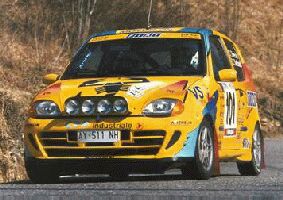 should
not be too hard (ie no race pads on the road) or they will not function
effectively at the normal 'road' operating temperatures. Stainless steel
braided flexible hoses will improve the pedal feel and reduce the chance
of damage whilst DoT5 fluid (not silicon) will increase the temperature
at which it can operate effectively. If the brakes are getting too hot
the dustguards can be removed and/or ducts fitted, taking air from behind the front bumper.
should
not be too hard (ie no race pads on the road) or they will not function
effectively at the normal 'road' operating temperatures. Stainless steel
braided flexible hoses will improve the pedal feel and reduce the chance
of damage whilst DoT5 fluid (not silicon) will increase the temperature
at which it can operate effectively. If the brakes are getting too hot
the dustguards can be removed and/or ducts fitted, taking air from behind the front bumper.
3. The suspension.
The easiest improvement,and the one which
will probably bring the single most noticeable change, is to replace the
full set of dampers and springs. A variety of kits are available which
include four matched dampers and springs. Top adjustable units are compromised,
but are good for road and track day cars since it allows the suspension
to be adjusted between these two, rather different, requirements. Coil
over units add more adjustability and can be purchased outright, or can
be made from standard dampers by welding a threaded sleeve to the standard tube.
Into this category also fall the choice
of wheels and tyres. With an increase in power it can be necessary to fit
larger tyres (thus requiring larger wheels) but the temptation to fit the
biggest possible should be resisted. Consideration should be given to fitting
a wider tyre on the front (since they provide traction and steering) but
keeping the standard, or a wider but not as wide as the front, tyre at
the rear. This will improve the balance of the car. There
are then two other main suspension aims; to reduce the flexiblity in the
suspension and to increase the stiffness of the car, both of which aim
at more accurate control of the wheel movement. To reduce the flexibility
it is possible to fit nylon bushes instead of the normal production rubber
items, or if perfection is desired the suspension can be fitted with metallic
bearings (rose joints / rod ends). Spherical bearing top mounts can also
be used. To stiffen the car it is most popular to fit strut braces. These
can be fitted to the front and rear. For more extreme cases a rollcage can be fitted.....
There
are then two other main suspension aims; to reduce the flexiblity in the
suspension and to increase the stiffness of the car, both of which aim
at more accurate control of the wheel movement. To reduce the flexibility
it is possible to fit nylon bushes instead of the normal production rubber
items, or if perfection is desired the suspension can be fitted with metallic
bearings (rose joints / rod ends). Spherical bearing top mounts can also
be used. To stiffen the car it is most popular to fit strut braces. These
can be fitted to the front and rear. For more extreme cases a rollcage can be fitted.....
4. other things.
Other modifications worth considering include
fitment of a shift light (and rev limiter if there is not one as standard),
higher power bulbs in the headlights (if you are going to go faster you
need to see further) and installation of a quicker steering rack.
Some inspiration..... if you really want
to go all out, then look at the Seicento Sporting rally cars. These have
a variety of modifications including individual throttle bodies and a beautiful
carbon-fibre air filter housing/duct and rose jointing of all the suspension.
They also fit a small oil cooler.
Buying / Selling
Some tips to do before selling :
(they may seem obvious, but most people don't do them and thus are in a
weaker bargaining position)
Tidy inside the car thoroughly : hoover
the floor, empty all pockets, ashtrays (wash), glove compartment etc...,
wipe the trim with a damp cloth, give the cockpit a good airing to get
rid of any odours ! Reset the trip meter to 00000 - it is a pleasant (subconcious) surprise.
If the car has been standing give it a
good run - this will clear out the engine (reduce exhaust smoke), put a
shine on the brake discs and loosen up any joints that may otherwise make some noises.
'Back to black' products are very effective
at temporarily restoring black plastic bumpers and trim. This makes a big difference
to any car. Do it a Jetwash under the car, especially under
the engine and in the wheelarches. The prospective buyer may be an enthusiast,
and this makes it easier for them to see what they want to check.
Obviously wash the car and clean the windows !
If you are going to buy a car always
check the following :
Firstly check the bodywork. Check that
there are no mismatching panels, large areas of discolouration or signs
of fresh paint (compare inside the engine bay with the external body colour),
all of which probably indicate accident damage.
Check the main electrical functions - wipers,
windows, lights, etc... try putting the main beam and wipers on at the
same time. Check the headlights for cracks.
Check the brake pedal does not go to the
floor if pressed hard for a long time and check the gearchange for clean engagement.
The engine should be run up to temperature,
check the exhaust for smoke, the condition of the breather (look for mayonaise),
the Due to the 'city car' nature of the Seicento,
you should also check for problems that arise from frequent short journey
useage such as damaged or blocked catalysts and noisy tappets (see oil
filler cap and breather above).
Check tyre wear, uneven patterns could imply a bent chassis.
Always take it for a test drive. Check
that the car tracks in a straight line with no steering input and also
remains straight under braking. Find a large open area and complete several
lock to lock turns (also in reverse), listening for any noises. Try the
handbrake when moving - seized rear callipers will mean uneven braking or no braking.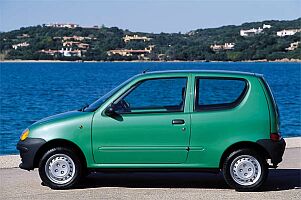 week
before you expect people to view the car, otherwise it may be a bit too obvious !
week
before you expect people to view the car, otherwise it may be a bit too obvious !
 condition
of the oil filler cap (again white deposits can indicate the use of the
car only on short journeys which causes excessive engine wear) and the
colour of the coolant (preferably not thick or dark brown!). Listen to
the noise of the engine, then depress the clutch and engage first gear.
Whatever noise has disappeared was coming form the gearbox, what remains
is from the engine. Also check the condition of the engine oil on the dipstick.The
lighter brown the better, if it is thick black then leave quickly.
condition
of the oil filler cap (again white deposits can indicate the use of the
car only on short journeys which causes excessive engine wear) and the
colour of the coolant (preferably not thick or dark brown!). Listen to
the noise of the engine, then depress the clutch and engage first gear.
Whatever noise has disappeared was coming form the gearbox, what remains
is from the engine. Also check the condition of the engine oil on the dipstick.The
lighter brown the better, if it is thick black then leave quickly.
Links
The UK Clubcento website
For books on Fiat see our Online Bookstore
There is also a list of all our picture galleries (including museums, motorshows and various events).
Wallpapers/Desktop Backgrounds of numerous Fiats also available to download.
Seicento comment form
Your Comments
I have read the Seicento
side of Your site and saw the desperate outcry for comments on the Seicento.
I have just ordered a Seicento SX so that my 6'4" son can learn to drive. Reasons?
It is the lowest insurance group of any car.
It is the only car less than ins grp 3 that he can fit in except the Punto. On all the others his knees hit the steering wheel, but on the Seicento,
the wheel was better positioned, and his knees are between the steering wheel and the dash.
He prefered it to the Punto because he could see the front of the bonnet.
It a real car! (Richard, UK)
Some comments about safety .When I first bought this car (2000) everybody keep telling me how small and UNsafe it is.well at September the 24 I had a very bad crash with my SPORTING as I was driving in the interstate a car tried to cross with red
light and I crashed on it with about 70 km/h having only 15 meters of braking.ME and my TWO friends got out of the car only with some bruzes from the safety belts.My sporting has been totally destroyied but I and two paseengers survived untouched.The driver of the other car hit a lot more siriously than us.(Kostas, Greece)
Well, I'd like to share
my tuning experiences with you all on this lovely little pocket rocket.
Some mods that have been carried out on the car:
Model: Fiat Seicento Sporting
Year: 1998
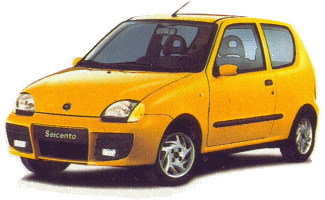 Engine: 1108 cm3
Engine: 1108 cm3
Max. Power output: 110 HP
Max. Nm: 146 Nm
Top speed: above 200 km/h
Acceleration from 0-100 km/h: 7,5 sec.
Modifications: Abarth MPI
System, Abarth Eprom, enlarged valves (intake from 29mm to 32mm, exhaust
from 27mm to 29,5mm), polished intake and exhaust channels, lightened and
balanced crankshaft, Giannini racing camshaft, lightened & adjustable
camshaft wheel, power boost valve, Champion Gr. A racing sparkplugs, Pipercross
direct airfilter system, Supersprint Gr. A manifold, decated stainless
steel 50 mm exhaust system, extra oilcooler, 6 speed Punto gearbox with
shortened 1st and 2nd gears, lightened flywheel, Sachs Gr. N clutch and
clutch plate, height and stiffness adjustable Novitec suspension ( lowered
by 60mm on the front, 50mm on the rear), Novitec strutbrace, 6x14 ET29
light alloy wheels with 195/45R14 Yokohama A510 tyres. Extra oil pressure
and temperature gauges and water temperature gauges have been installed.....
.... and the car is for street use!! (Victor, Hungary)
Another very satisfied seicento sporting owner here!
I drove my seicento all the way from Greece to England in 2 days carrying
*alot* of luggage. Now I'm thinking of touring Spain on my way back. Great car!
I recently bought a 2000 Fiat Seicento to replace my aging and
mechanically unsound Fiesta. I'm amazed by it! I managed to get about 93
mph from its 899cc engine (sshh - don't tell the police) and it handles
better than any car I've ever been in. Most amazing is the fact that
there's so much legroom, both in the front and in the back! The power
steering makes parking a doddle in these congested times and it's so
cheap to run - I'm happy. It's like driving to work in a go-kart! (Steve, UK)
Hi ,
I recently bought a V-Reg (5 years old) Seicento Mia with a paltry 8k on the clock for 3000 from a main dealer with warranty . After reading some really horrible comments on it on various
websites , i'm actually starting to wonder if this is the same car people like moaning about ?!!? Not only is it 'cheap as chips' to run and insure , but i too have had the best part of 100mph
out of an engine that should do 'only 87' !!!
My new Fiat Seicento Sporting is my first ever car and I've had it for just over a year now.
It is absolutely brilliant fun - point and shoot, goes like a little rocket, and more than enough attitude! Of course it's bright yellow too! Excellent car!
Not only that but it is incredibly roomy , quiet and well-built and even sounds like a formula 1 car at high revs !! I previously owned a chipped 2 litre Rover Turbo and despite producing 200bhp
less , the Sei is no slower around town at all - and nearly a thousand pounds a year cheaper to insure ! The best car i've ever had without doubt and i've had 'em all !!!
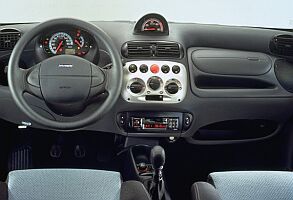
Use the buttons at the top to navigate further, or
Copyright © 2000 to 2008 CarsfromItaly